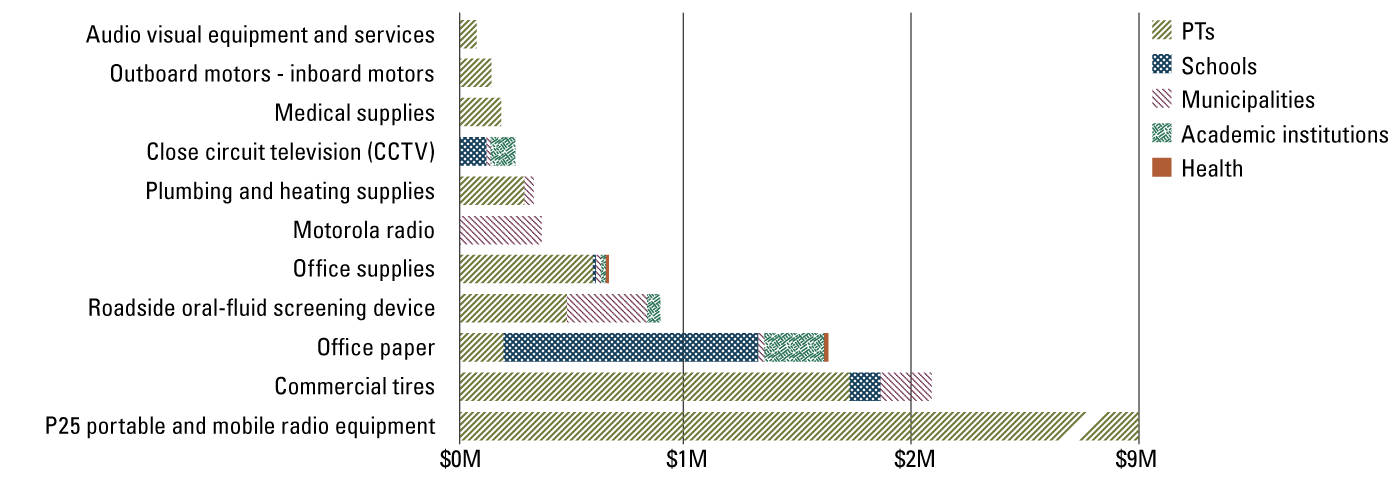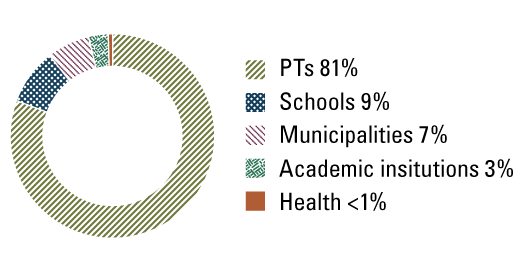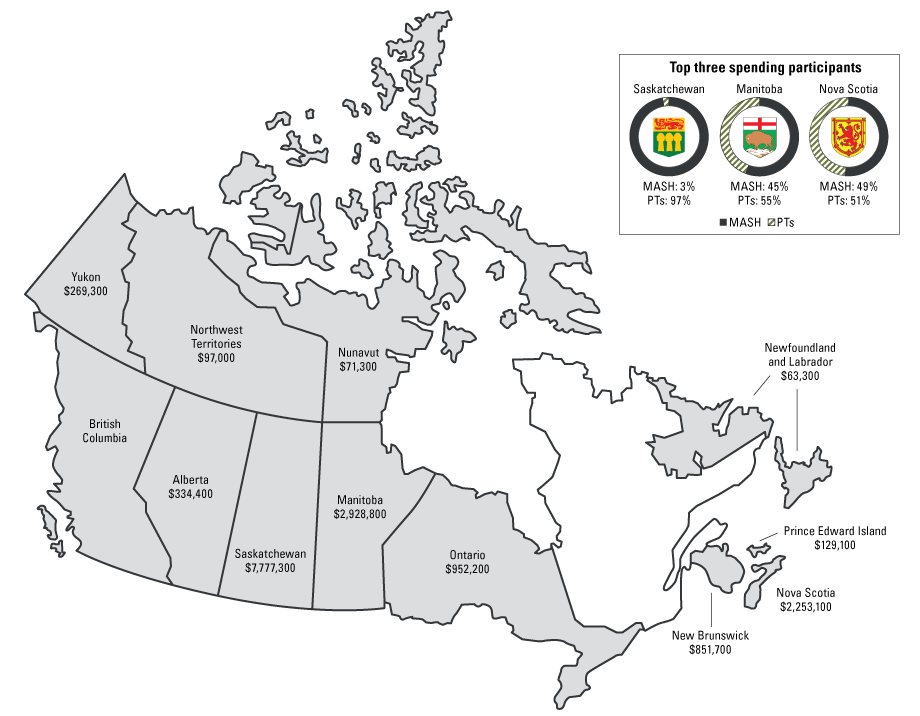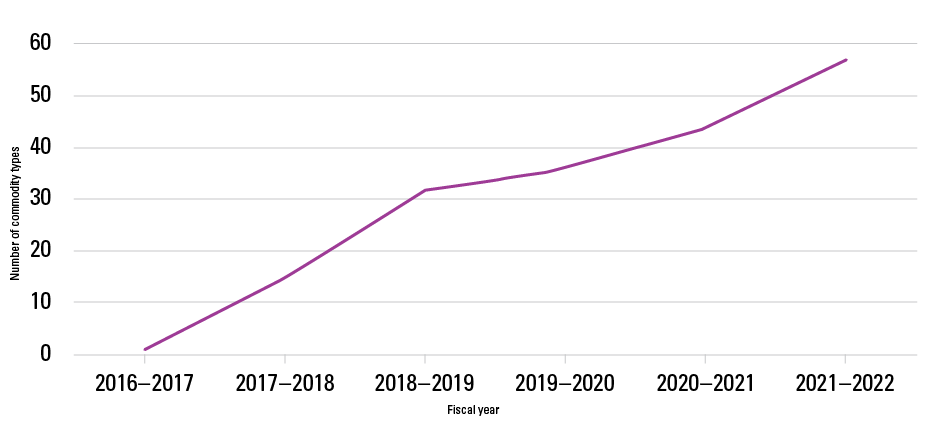2022 Canadian Collaborative Procurement Initiative year in review and look ahead
To procure goods and services at a better value, the Canadian Collaborative Procurement Initiative (CCPI) shares selected federal procurement tools with:
- 12 provinces and territories (PTs)
- over 200 entities from municipalities, academic institutions, schools, and hospitals (MASH)
- 1 Canadian public health organization
The broader public sector is benefiting from access to almost 60 types of commodities.
The CCPI provides support to its participants by sharing procurement tools which:
- satisfy their buying needs
- reduce costs
- generate administrative efficiencies
- obtain better value
- meet their socioeconomic goals
On this page
Achievements
In the 2021 to 2022 fiscal year, total spending by CCPI participants on CCPI standing offers (SOs) amounted to $15.7 million. This is a 138% increase from last year. It is clear that CCPI participants continue to benefit from public procurement.
Many CCPI commodities have seen an uptake of usage this fiscal year. For example, there is a significant increase in the usage of commercial tires, with total spending close to $2.1 million, a 96% increase from the last fiscal year. This is due to increased usage from MASH entities (171%) and PTs (85%). The most successful commodity of this fiscal year is P25 portable and mobile radio equipment. Multiple PTs benefited from the CCPI SOs and collectively purchased $8.8 million worth of supply.
Canadian Collaborative Procurement Initiative 2021 to 2022 spend
In this section
Total spend value for goods purchased by participants over the past year
- Audio visual equipment and services: $94,000
- Close circuit television (CCTV): $270,700
- Commercial tires: $2,086,900
- Medical supplies: $194,200
- Motorola radio: $377,700
- Office paper: $1,622,300
- Office supplies: $652,500
- Outboard motors and inboard motors: $144,300
- P25 portable and mobile radio equipment: $8,860,800
- Plumbing and heating supplies: $322,400
- Roadside oral-fluid screening device: $886,400
Total spend value for goods purchased by type of participant

Image description
This bar graph shows the total spend value for goods purchased by type of participant and CCPI commodities:
- audio visual equipment and services:
- PTs: $94,000
- total spending: $94,000
- outboard motors and inboard motors:
- PTs: $144,300
- total spending: $144,300
- medical supplies:
- PTs: $194,200
- total spending: $194,200
- close circuit television (CCTV):
- municipalities: $6,700
- academic institutions: $139,800
- schools: $124,200
- total spending: $270,700
- plumbing and heating supplies:
- municipalities: $23,000
- PTs: $299,400
- total spending: $322,400
- Motorola radio:
- municipalities: $360,900
- PTs: $16,800
- total spending: $377,700
- office supplies:
- municipalities: $17,000
- academic institutions: $24,500
- schools: $7,700
- health: $5,800
- PTs: $597,500
- total spending: $652,500
- roadside oral-fluid screening device:
- municipalities: $341,600
- academic institutions: $52,600
- PTs: $492,200
- total spending: $886,400
- office paper:
- municipalities: $16,200
- academic institutions: $276,900
- schools: $1,126,300
- health: $1,800
- PTs: $201,100
- total spending: $1,622,300
- commercial tires:
- municipalities: $223,800
- schools: $138,300
- PTs: $1,724,800
- total spending: $2,086,900
- P25 portable and mobile radio equipment:
- PTs: $8,860,800
- total spending: $8,860,800
Percentage of total spending by participant type
Note: Percentages do not total 100% due to rounding.

Image description
This circle graph shows the percentage of total spending done by participant type:
- PTs: 81%
- schools: 9%
- municipalities: 7%
- academic institutions: 3%
- health: less than 1%
Total spending in each province and territory

Image description
This map of Canada consists of 2 images:
The first image is a map of Canada, it details the total amount of spending in each province and territory:
- Saskatchewan: $7,777,300
- Manitoba: $2,928,800
- Nova Scotia: $2,253,100
- Ontario: $952,200
- New Brunswick: $851,700
- Alberta: $334,400
- Yukon: $269,300
- Prince Edward Island: $129,100
- Northwest Territories: $97,000
- Nunavut: $71,300
- Newfoundland and Labrador: $63,300
- British Columbia: $0
- Grand total: $15,766,500
The second set of images are 3 pie graphs showing the percentages of total spending by MASH and by provincial government in Saskatchewan, Manitoba, and Nova Scotia:
- Saskatchewan:
- MASH: 3%
- province: 97%
- Manitoba:
- MASH: 45%
- province: 55%
- Nova Scotia:
- MASH: 49%
- province: 51%
As of April 2022, there are over 200 participating MASH entities in CCPI an increase of almost 15% increase in comparison to last fiscal year. The greatest increases in the volume of MASH entities joining the CCPI were in Manitoba and Ontario.
Out of the new participants that have joined, many have already started to use and benefit from CCPI offerings. For instance, Park West School Division in Manitoba joined this fiscal year and already purchased office paper. The Nunavut Health Authority, purchased through CCPI for the first time and benefited from the medical supplies SOs.
The 3 provinces with the highest amounts of CCPI spending include:
- Saskatchewan
- Manitoba
- Nova Scotia
All 3 territories continue to benefit from CCPI, they have spent a total of approximately $438,000.
Total amount of commodity types available each year

Image description
This image shows the total amount of commodity types available each year between 2016 to 2022:
- 2016 to 2017: 1
- 2017 to 2018: 15
- 2018 to 2019: 32
- 2019 to 2020: 36
- 2020 to 2021: 44
- 2021 to 2022: 57
Each year, more commodity types are added to the CCPI offerings. There are now 57 active types of commodities offered through CCPI. This is an increase of over 30% from the last fiscal year. Some of the new commodity types include:
- voice projection units
- electronic fingerprint capture devices
- compostable single use service ware and utensils
New standing offers for services are also available, including:
- laboratory water testing services
- guard services
- temporary help services
New offering this year in Ontario region
CCPI added dairy products and fresh produce to its offerings in the 2021 to 2022 fiscal year and they are now available for purchase in the Ontario region.
Social procurement and diverse suppliers
Meeting socioeconomic goals through public procurement is an integral part of CCPI. CCPI is always pursuing the advancement of various socioeconomic objectives that empower different levels of government and the MASH entities to support small and medium enterprises (SMEs), Indigenous businesses and green procurement initiatives alongside the federal government.
As of April 2022, 80% of CCPI’s diverse suppliers are SMEs. CCPI also continues to steadily create more opportunities for Indigenous businesses. 18 of the 57 commodity types available through the initiative include a procurement strategy catered towards Indigenous businesses.
Keeping abreast with changes and new realities, CCPI is actively expanding its offerings to include greener commodities. For example, 6 green commodity types are available through CCPI SOs this fiscal year amounting to a total spending of $2.6 million by CCPI participants.
Testimonials
Commercial tires, Yukon
The Government of Yukon has been a long-time participant of the collaborative procurement with Public Services and Procurement Canada (PSPC). For many years, we and our MASH sector (City of Whitehorse) have been consistently procuring commercial tires for all of our fleet via the CCPI.
Yukon assesses the benefits for participating in the cooperative procurements where the good or service may be required. It is another tool in our toolbox for our procurement staff to access. The Government of Yukon promotes and shares information about these collaborative opportunities.
Government of Yukon collaborative purchasing agreements
I have found PSPC very helpful and responsive.
Streamline procurement in Manitoba
I have noticed how much easier our purchases are now through CCPI. Knowing exact pricing prior to purchasing rather than just expecting a good price from the suppliers works well. I am still learning just how much benefits there can be with respect to being a CCPI participant and hopefully I will have more time in the future to look into the program more extensively.
The year ahead: 2022 to 2023
Launch of professional services pilot
Starting in June 2022, CCPI participants have access to a pre-qualified suppliers directory under specific professional services categories for their procurement needs, including:
- project management services
- health services
- alternative dispute resolution services
- cyber protection services
- geomatic services
To access the directory, CCPI participants can log onto the Standing Offers and Supply Arrangements Application (SOSA App) and find the information filtered by specific professional services categories. It is an expansion of CCPI to include professional services. By extending access to the PSPC’s professional services procurement directory, the pilot provides an additional economic benefit to both professional services suppliers and CCPI participants.
Green procurement
To fight climate change through pollution reduction, CCPI will continue to support the adoption of green procurement. This will accelerate the transition to a net-zero economy by adopting new, clean technologies like electric snowmobiles and vehicles hybrid conversion kits.
Promotion and outreach
Promotion of CCPI has been at the forefront of our activities this year, with extensive planning for original campaigns and materials for the next fiscal year already on the way. Coordination with the regional PSPC offices, to have a better understanding of our provincial and territorial partners’ needs, continues to be a priority in the upcoming fiscal year.
CCPI is always keen to reach out to participants and introduce CCPI to those who could benefit from buying together. Looking at the year ahead, CCPI has launched a new format of interactive sessions through virtual townhalls. These CCPI townhalls aim to make the initiative accessible to those who have concrete questions on the use of procurement tools or even accessing the information. Let us know if you would like to book a CCPI townhall for an association of municipalities, an organization of MASH entities or a region. Our team is responsive and will adapt these activities to best meet your needs.
More information
How to join
Learn how your organization can join the CCPI and how to connect with your respective provinces or territories for the onboarding/enrollment processes.
How to join the Canadian Collaborative Procurement Initiative
Find commodities you need: Commodity interest form
Fill out the commodity interest form to select your commodities of choice.
Canadian Collaborative Procurement Initiative 3 year plan: Commodity interest form
Contact us
Contact us for information, suggest commodities of interest and to schedule a townhall with our team:
- Date modified: